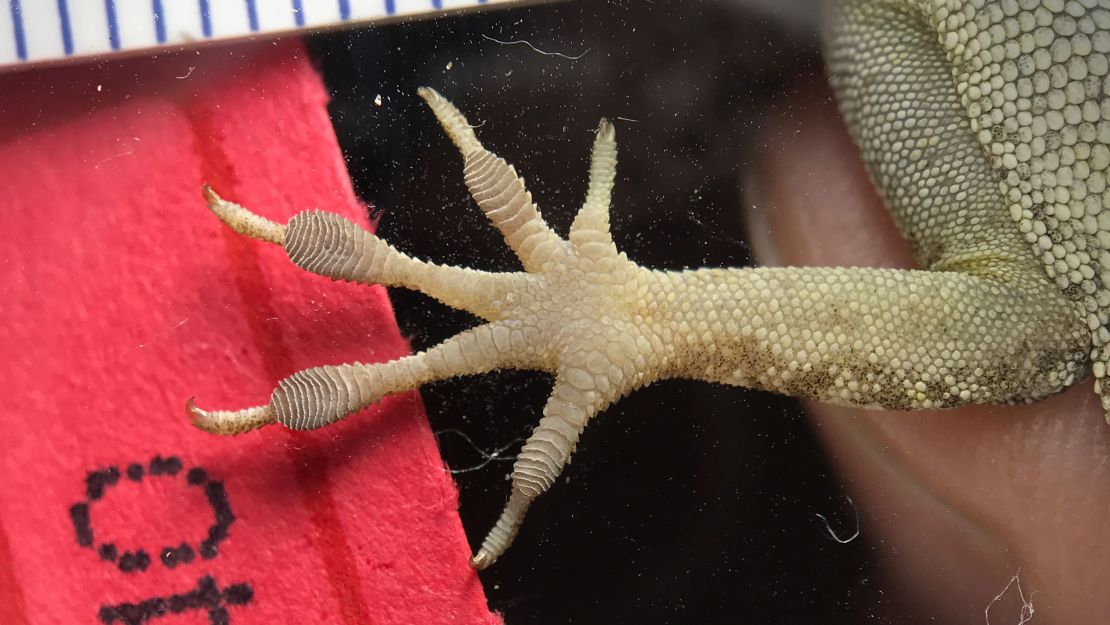Lizards can evolve adaptations that could make them more likely to survive certain effects of climate change.
That’s according to Colin Donihue, a post-doctoral fellow at Washington University in St. Louis, who authored a study published on Monday in the Proceedings of the National Academy of Science.
He examined lizard species on several Caribbean islands, and found that lizards’ toe pads are larger and stronger on the islands on which more hurricanes strike. In areas with fewer hurricanes, the lizards don’t have toe pads as large – because they don’t need them, he said.
“It could have a much wider effect across lots of species,” Donihue explained. That might mean trees, birds, mammals and insects might be capable of the same feats of tropical resilience.
Lizards were a little different after hurricanes
The process began in 2017, as Donihue was studying lizard populations in Turks and Caicos, specifically on the islands Pine Cay and Water Cay. A couple weeks after he and fellow researchers departed, those islands were pounded by hurricanes with up to 170 mph winds – first Hurricane Irma and then Hurricane Maria.
Returning to the island a year later, he noticed that “the populations looked differently.” The lizards he saw after the hurricanes had larger toe pads than those he’d examined the previous year before the hurricane.
He has now looked at 12 island populations of the lizard species Anolis sagrei, or brown anole, and separately analyzed 188 Anolis species with populations that range from Florida to Brazil. He and his team cross-examined the size of their toe pads with the frequency and severity of Caribbean hurricanes.
Over the past 70 years of hurricane data, the pattern stood out: Larger toe pads were correlated with more severe hurricanes.
The study broke new ground in evolutionary science
The study offered new insights into how evolutionary processes are helping species adapt and become more hardy, even as global climate change threatens their long-term survival.
“It’s been long known that anoles elsewhere have smaller toe pads than in the Caribbean,” said co-author Jonathan Losos, a professor at Washington University in St. Louis’ department of biology whose lab oversaw the project.
He preferred the notion that Caribbean lizards fight each other more and the lucky victors in those battles were the ones with the larger toe pads. In the past, hurricanes simply haven’t been common enough to matter in an evolutionary time line. Hurricanes here and there might cause one-off devastation, but Losos, and others in the field, didn’t believe adverse weather events amounted to the perennial pounding that could prompt natural selection to kick in.
Losos was skeptical of Donihue’s hypothesis and tried to dissuade him from heading back to Turks and Caicos and embarking on what he regarded as a fool’s errand.
But Donihue went down anyway – and proved his mentor wrong in the process.

Hurricanes can sweep up lizards that can’t hold on
On revisiting Turks and Caicos in 2018, Donihue saw that the new lizards, the offspring of the survivors of the hurricanes, had similarly large toe pads.
“They looked exactly like their parents,” he said.
That small change in anatomy gives us a big clue about how species change as the environment around them changes as well.
“Some populations can be completely wiped out in hurricanes,” Donihue said. But in the case of the lizards he studied, the ones that survived these violent storms were the ones with larger toe pads.
These larger toe pads are “advantageous for holding on tight,” he noted, and that little extra edge can save lizard lives.
“If it gets blown into the air, it’s entirely possible it gets blown out to sea,” Donihue says. Buffeted by hurricane-force winds and rain, lizards with inferior toe pads face a violent death, whether that be by drowning in the ocean, being thrown against rocks or being swept into a tree.
Other species could also be adapting to climate change this way
This study could have implications for all Caribbean species. “We know that due to climate change, there will be more hurricanes,” Donihue said.
As that happens, this could give us clues into which species have the ability to survive longer-term.
We don’t know yet for certain, but Donihue and his colleagues suggested that Caribbean birds might be able to adapt longer talons to hang on to tree limbs and not get thrown off into the howling winds.
Donihue felt that trees might be an important candidate to study in the same fashion. Trees populations that withstand future hurricanes might have some other adaptations that set them apart in the increasingly tempestuous 21st century.
Aside from reducing emissions and slowing global climate change, humans can’t do much in the short term to reduce the frequency of severe Caribbean hurricanes, and therefore preserve these species.
But one silver lining is that species can adapt, and we can even see their tweaks on a yearly basis.
“One of the findings that’s impressing me the most is just how resilient these species are,” Donihue said.





